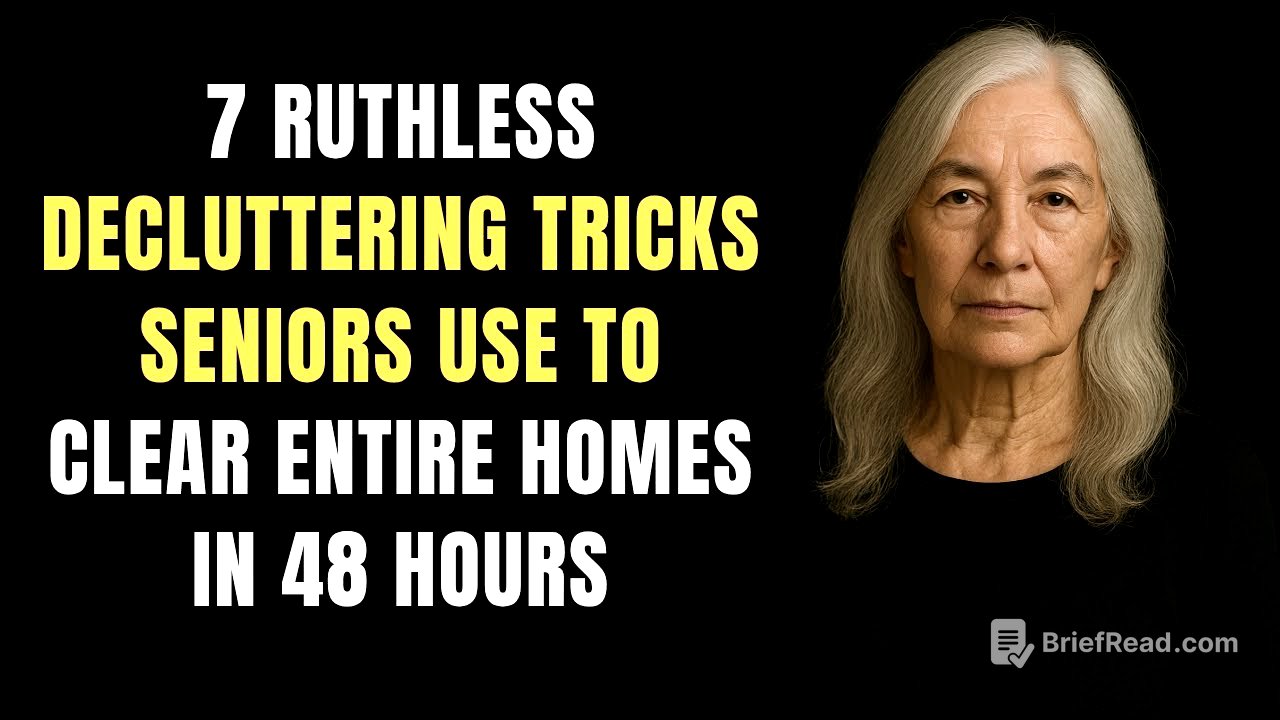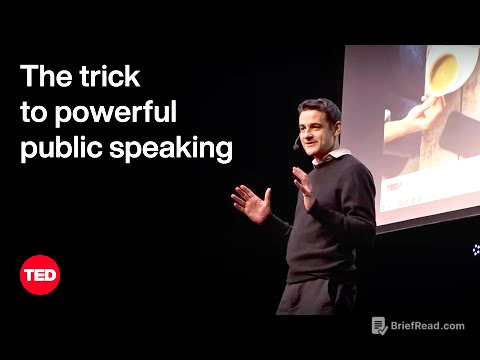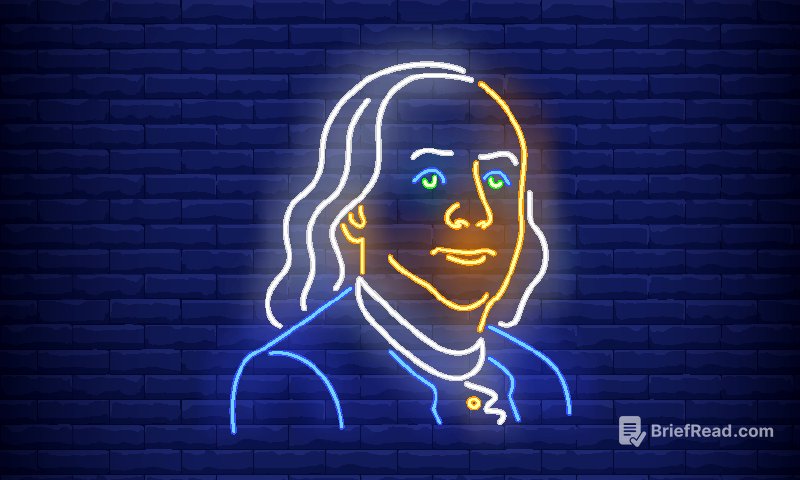TLDR;
This video shares seven unconventional decluttering tricks that helped a 73-year-old woman named Vivian clear her home in 48 hours and feel liberated for the first time in years. These tricks are designed for seniors dealing with a lifetime of possessions, limited energy, and emotional attachments. The core strategies include the triage method, timed decluttering sessions, the "stranger test," a replacement reality check, an energy investment scale, a future self test, and completion ceremonies.
- Triage method for quick categorization
- 10-minute timed decluttering sessions to prevent overwhelm
- "Stranger test" to remove emotional attachment
- Replacement reality check to counter "just in case" mentality
- Energy investment scale to prioritize emotional energy
- Future self test to align possessions with aspirations
- Completion ceremonies to honor and release items
Introduction [0:07]
Vivian, a 73-year-old woman, faced the daunting task of decluttering her three-bedroom home filled with 40 years of memories in just 48 hours before a move. Her adult children lived far away, leaving her alone with decades of accumulated possessions. Instead of being overwhelmed, she used seven unconventional tricks to clear her home and feel liberated. These tricks are designed for seniors dealing with a lifetime of possessions, limited energy, and emotional attachments.
Triage Method [2:02]
Vivian used the triage method, borrowed from emergency medicine, to quickly categorize her possessions. She divided everything into three categories in 15 minutes per room: "can't live without it" (medications, important documents, daily essentials), "might need it someday" (danger zone), and "haven't touched it in over a year" (automatic elimination). Category 2 was treated like category 3, as Vivian realized that "might need it someday" is often fear-based. She started with her kitchen, identifying excess items like 23 coffee mugs (when she only drinks tea), three china sets, and numerous kitchen gadgets. She kept two mugs, donated the china, and trashed most gadgets. This process helped her realize that keeping everything "just in case" made her feel trapped and overwhelmed.
10-Minute Timer [4:56]
Vivian set a timer for 10 minutes per small area (closet shelf, kitchen drawer, bathroom cabinet) to avoid exhaustion and mental fatigue. Seniors have limited emotional decision-making energy, and after 10 minutes, decision fatigue sets in. Stopping when the timer went off prevented overwhelm. In 10 minutes, overthinking is impossible, forcing reliance on gut instincts. Vivian tackled her bedroom dresser, finding expired medications, non-working pens, old Christmas cards, and manuals for discarded appliances. She filled a trash bag in those 10 minutes and found forgotten space. By ending each session with energy and clarity, she looked forward to the next one. She completed 24 sessions on day one, totaling four hours of decluttering without feeling drained.
Stranger Test [8:20]
Vivian pretended a stranger would be going through her belongings after she was gone. This removed emotional charge and provided clarity. She asked herself, "Would a stranger understand why I kept this or would they think I was a hoarder?" A stranger would toss old magazines, donate unused candles, and condense photo albums. She applied this to sentimental items like her children's artwork, keeping the 10 most special pieces and letting go of the rest. She condensed 23 photo albums into three. This approach helped her keep items that genuinely added value to her current life.
Replacement Reality Check [11:48]
Vivian addressed the fear of needing something someday and not being able to replace it with a "replacement reality check." She asked three questions: "If I needed this item tomorrow, could I realistically get another one?", "What would it actually cost me to replace this item in today's market?", and "In the last 5 years, how many times have I actually needed this specific item for anything important?" This destroyed "just in case" justifications. For example, she had 12 screwdrivers but could easily replace them for under $15. Holding on to everything was costing her storage space, mental stress, and cleaning time. She applied this to craft supplies, furniture, and kitchen appliances.
Energy Investment Scale [15:52]
Vivian created an energy investment scale from 1 to 10 to prioritize her limited emotional energy. Level 1 items (romance novels) went straight to donation, while Level 10 items (grandmother's cookbook) received careful consideration. Her late husband's technical manuals rated a three, and her grandmother's cookbook rated a nine. This prevented emotional exhaustion. She cleared her closet in 45 minutes instead of a weekend. She discovered that the items she worried about most were often the least important to her daily comfort. She cleared 80% of her garage by refusing to invest emotional energy in items that didn't serve her current reality.
Future Self Test [20:09]
Vivian made decluttering decisions based on who she was actively becoming, not who she used to be. The "future self test" asks, "Does keeping this item serve the person I'm growing into, or is it anchoring me to a past that's already complete?" Her business suits represented her past career, but her future self was a relaxed retiree. She cleared space for new interests like gardening, travel, and art. She kept the most meaningful items of her late husband's but donated the rest to help other families. Her future self wanted a simple, peaceful kitchen, so she donated commercial-grade equipment.
Completion Ceremonies [24:23]
Vivian created meaningful completion ceremonies for each category of items she released. This transformed guilt into gratitude and prevented second-guessing. For her business wardrobe, she created a career celebration ceremony. For books, she wrote thank you notes to authors. For photos, she held a memory celebration. Her adult children's artwork received a digital album. She created retirement ceremonies for broken items. For items connected to her late husband, she created a love celebration. These ceremonies reinforced that she wasn't losing her past but celebrating her life's journey.
Conclusion [28:59]
Vivian was ready when the moving truck arrived. She packed what served her future self, donated 12 truckloads, and said proper goodbyes. Three months later, she was teaching art classes, volunteering, and dating. The seven tricks helped her discover who she was becoming. Decluttering isn't about getting rid of things; it's about making room for the life you want to live.









